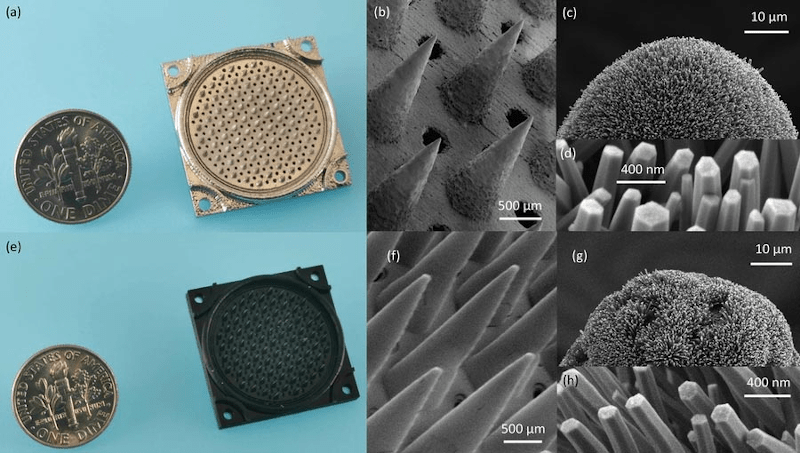As much as we love Star Trek, we have to admit there are some continuity problems. For example, in Spock’s Brain, the alien-of-the-week’s ion drive gave Scotty engineering envy. However, in The Menagerie, the computer identifies a Starfleet shuttlecraft as having ion propulsion. Either way, ion propulsion is real and NASA has toyed with it for ages and many satellites use it for maintaining orbit. Now researchers from MIT and the Monterrey Institute of Technology and Higher Studies 3D printed tiny ion engines.
The engine is about the size of a dime and, like all ion engines, produces tiny amounts of thrust. In fact, the researchers liken it to half the weight of one sesame seed from a hamburger bun. However, in space, these tiny thrusts add up and over time can produce significant acceleration.
The full paper is available and shows the device operates electrohydrodynamically, creating a fine spray of charged particles. Interestingly, the device is capable of creating fine sprays of liquid or nanofibers, so the applications aren’t just for space vehicles. However, the researchers were actually surprised that the device creates a pure ion jet and they aren’t entirely sure how the device works.
The device has a reservoir of liquid with an array of emitter cones. The cones are coated with zinc oxide nanowires that act as wicks to transfer the liquid to the emitter tips where the liquid is ionized and expelled. The researchers think the nanowires are responsible for the creation of the pure jet of ions.
An ion-powered spacecraft is visiting Mercury. The ion drive we really want to see, though, is on our very own pedal-driven space bike.
















I think I understand your problem: your didn’t wipe Spock’s Brain from your memory. Life is better if you do that.
I remember Obama giving a speech about how that one type of ion engine was a necessary part of getting to Mars…. what ever happened to that?
I guess it wasn’t all that good… https://spacenews.com/vasimr-hoax/
i disagree that it was a hoax. a bad design that somehow got government funding (like the government doesn’t commonly spend money on things that don’t work). existing ion drives (hall effect thrusters are the ones you want) could be scaled up quite readily if a suitable space power system was available. the most we have done with solar is the 240kw solar array on the iss. that represents considerable mass for a spacecraft. and a nuclear reactor has a similar problem with its heat rejection system as well as the reactor itself. either one requires a lot of panel or radiator area. a plasma thruster that could actually move crew around the solar system would need to have a megawatt or more power available to it.
at present chemical engines to mars are the best approach. this means you need a large ship with a big gas tank. good thing we have a crazy mad scientist type building one.
Hmm…Zubrin spent a lot of time and energy VASIMR-bashing back then, that could’ve been spent better elsewhere.
Still, his points about its power requirements and the power-to-mass ratio of nuclear reactors (including waste heat radiators) that would provide its electricity, did deserve an answer.
sounds like an accidental feep thruster.
dime sized if you could print 100 or more in space.
‘”… these tiny thrusts add up and over time can produce significant acceleration”
OK, I’ll be that guy. Tiny thrust means tiny acceleration. But over time even a tiny acceleration can build up a significant velocity.
So size does count then. Boo.
Only if you’re fast enough
I was going to point that out. Acceleration is per unit time, so it can’t increase because of increasing time.
Came looking for this comment.
Huh? The shuttlecraft engines are simplified impulse engines, which are descendants of ion drive engines. And we do have ion drive engines on a satellite. Right now she’s out there in the region where Pluto is based.
You do know “impulse engines” aren’t really a thing, right? And actually in the imaginary world of Star Trek original the shuttle craft was warp capable.
To another poster: Talking about solar power is just silly. Just keep using plutonium and thermocouples.
Is it? We are part of their past. And yes some of the shuttles were capable of Warp 3 when necessary.
Y’see, this is another example in favor of allowing edits, say within 5 minutes of posting. But I wouldn’t want to interfere with your Akismetian religious practices.
Name one satellite that started on Earth and is now “in the region where Pluto is based.” That’s a big effing “region”. While you’re at it, “satellite”? Rilly?
The New Horizons went out to examine Pluto. After that she went off to examine the other planetoids that are out there. I only report what that amazing sat is up to.
There were experiments with use of a very similar structure to produce flat panel CRTs decades ago.
I did some unrelated research with ionic liquids (the propellant in question) a while back. Turns out they’re a very flexible material class, and I researched one called 1-butyl-3-methylimidazolium acetate that could scrub CO2 from a spacecraft atmosphere nicely.
It dissolves it? How do you regenerate it, release the CO2 ?? …. coz if you can dump it into a sealed pod for plants, that would make them grow way more efficiently. Then you need an O2 concentrator I guess to punt that back into the crew air.